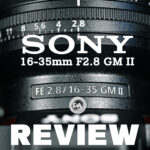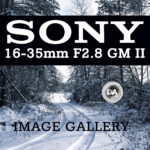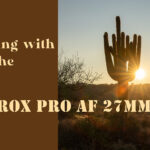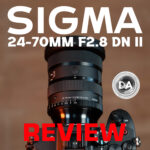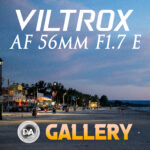
Sony EV-10 II Review
What do people want in a small, portable camera? A fixed prime lens and a camera high on style, like Fuji’s X100VI that I reviewed earlier this year? Or Sony’s own ZV-1 II camera with a fixed zoom lens? But Sony also has the third option covered, and that is a compact vlogging oriented camera with a more typical interchangeable lens mount. The Sony EV-10 II is Sony’s second generation vlogging specific interchangeable lens APS-C mirrorless camera. The main improvements are the upgrade to the 26MP sensor found in the a6700 (from the 24M sensor of the original EV-10), improved autofocus, much more robust video specs, and an upgrade to the common NP-FZ100 battery found in most of Sony’s better cameras. Does all of this add up to a camera worth considering? Find out my full thoughts in my video review below or read on in my text review.
Follow Me @ YouTube | Patreon | Instagram | Facebook | DA Merchandise | Flickr | 500px | X
Thanks to Sony for sending me a review loaner of this camera. As always, this is a completely independent review. All thoughts and opinions are my own.
__________________________________________________________________________________________________
So what are the key features here?
- 26MP APS-C Exmor R CMOS Sensor
- UHD 4K30 and Full HD 120p Video
- 3.0″ Touchscreen LCD, Vertical Support
- 759-Point Fast Hybrid Phase Detection
- Up to 11-fps Shooting, ISO 100-32000
- Real-Time Eye AF and Tracking
- Background Defocus, Product Showcase
- Focus Breathing Compensation
- Directional 3-Capsule Mic and Windscreen
- E PZ 16-50mm f/3.5-5.6 OSS II Lens
And what are the main things that are missing that people will be looking for?
- No viewfinder
- No IBIS

Bottom line: at a price tag of right under $1000 for the camera alone ($1100 with the PZ 16-50mm lens), this is the cheapest camera to get Sony’s new 26MP sensor and updated AF system. My experience says that you can get cheaper CAMERAS from other brands, but if you are interested in using more than one or two lenses, nothing beats Sony E-mount for lens selection and thus lower costs in the long run.
Build and Handling
The ZV-E10 II is a very compact and lightweight camera, though it has grown a little bit since the original ZV-E10. The dimensions are 114.8 x 67.5 x 54.2 mm (w x h x d), or 4.5 x 2.7 x 2.1″. The width is the same as the first generation camera, but the height has grown by 3mm and depth by 5.5mm. This is mostly to accommodate a very positive change – the swap from the smaller NP-FW50 battery (1080mAh) to the larger NP-FZ100 battery (2280mAh) employed in their better cameras.

The weight of the camera with the battery and memory card inserted rises a bit, from 343g to 377g (13.3oz). There are always two perspectives about this kind of change, as for some people their absolute priority is to go as small and light as possible. But this change increases the rated number of shots from the ZV-E10’s 440 shots and 80 minutes of actual video recording to 610 shots and (perhaps more important in a vlogging camera!) 130 minutes of actual video recording time in the ZV-E10 II. That’s an additional 50 minutes of video recording, and while it is often fairly easy to swap batteries when shooting stills, having to swap batteries during long format video recording can be disastrous. Having a spare battery or two is still a good idea, but there’s no question that you’re better off with this level of battery life if you were going out for a day in a new city while traveling or vlogging. It’s much more likely that 130 minutes of recording time would get you through the day if you just had a camera on a strap around your neck than 80 minutes.

The secondary takeaway from this is that you get a much more robust grip than you did on the ZV-E10. You can see that the original grip is rather small, while the ZV-E10 II has a more accommodating grip that gives more space for the fingers to wrap around it. I found that the camera still wasn’t tall enough to accommodate my hands (my pinky has to wrap underneath), but my other fingers were comfortable on the grip.
You can see from the comparison image above that the extra grip space has allowed for a minor restructuring of controls. The Powerzoom controls remain at the front of the camera, but the ON | OFF lever has moved from a separate switch mid camera to a position to the right of the shutter button. I found that I did sometimes hit the Powerzoom control when trying to turn off the camera due to not having the muscle memory initially, but the advantage of having the power toggle there is that it is much easier to control the camera one handed.

The video record button and the C1/Background Defocus button are in the same location as before, but the mode control has changed from a button selector to a three position switch (STILLS | VIDEO | S&Q).

This is a better system, as it gives quick and direct control as opposed to having to interact with the LCD screen.
The C1/Background Defocus button is unique to this type of camera, and it’s native purpose is to open the aperture to the widest option to defocus the background. That’s only going to have limited effectiveness with a slower lens like the kit zoom, as this doesn’t actually magically make backgrounds more defocused. I did note that (as expected) that this feature will not work with a lens with an aperture ring unless you have the aperture ring in A (auto) mode. If you have an aperture preset and hit the button, you will get this message:

I personally wouldn’t find this function particularly useful, as I’m always aware of aperture and can quickly switch it to my preferred aperture setting anyway, but those who want to operate as simply as possible might appreciate this function. This also serves as the C1 button, however, which means “customizable”, so you can assign many other values to it instead if you don’t want or need a Background Defocus option.

The ZV-E10 cameras have a unique and more robust built in microphone. This three-capsule microphone is more robust than most on-board microphones, with better pickup and noise reduction performance (a wind reduction muff is included). You have the option of choosing Auto recording or choose from Front, Rear or All Directions settings to match your shooting environment or priorities. This might allow you to prioritize getting sound from in front of the camera, or recording your voiceover behind the camera, or mixing the environmental sounds with your voice. Further expanding your options is the fact that the “hotshoe” is Sony’s MI-shoe, or multi-interface shoe. This will allow you to record digital audio through a compatible microphone.

The bottom of the camera is mostly the same, though the battery door is oriented a little differently to accommodate the larger battery.

The font view is largely the same. The slightly taller body of the ZV-E10 II makes the LCD screen look a bit smaller, but both are a 3″ fully articulating touchscreen LCD. The resolution is slightly higher at 1.036 million dots rather than .921m dots on the older model. Sony’s touch capabilities have improved over the past few years, and are now more responsive and allow for full menu navigation and many other options.

I have zero complaints about the LCD screen itself, though…
There is no viewfinder in this design, and (due to muscle memory) there were many time that I pulled the camera up to my eye only to then remember that there was no viewfinder. I did find that in bright sunny conditions that I really missed having a viewfinder, as seeing the LCD screen in some lighting was difficult.

The right side view is mostly the same, though the difference in the thickness of the camera is very apparent from this angle. The grip material is a bit different than the typical grip on, say, the a6xxx series. It’s largely a series of raised microdots.


A bigger change is found on the left side of the camera, as (thankfully!) the single UHS-II rated SD card slot has been relocated to the side of the camera instead of in the battery compartment on the bottom of the camera. I vastly prefer the side location, as bottom locations will often be interfered with if you are using a QR plate or something similar. This change means that there is a slightly different organization of the ports located there, though it adds up to the same thing.

The USB-C and microphone input are located in the top compartment, with the micro-HDMI and headphone monitoring jack located in the bottom compartment. The new SD card slot falls in the middle of the two.
The rear view is pretty much identical, though with a minor change to the top plate and a little sculpting to allow easier access to flipping out the screen and for accessing the top wheel. All other button and dial positions are the same.

The controls are adequate, and between the two wheels it is easy enough to control most functions.
The Powerzoom controls have two functions. If you have a Powerzoom lens attached (like the E 16-50mm F3.5-5.6 PZ OSS II lens), you can directly access the Powerzoom function in a much easier way than by the controls on the tiny lens itself. A secondly application is in video mode, however, and it will allow you to control the Clear Image Zoom or Digital Zoom function. It’s very welcome to have the ability to smoothly control zoom and be able to get smoother results for video.


The ZV-E10 II can be bundled with the Sony E PZ 16-50mm f/3.5-5.6 OSS II lens. The lens retails for $298 when sold separately, but only adds $100 when sold in a bundle with the camera. It’s worth getting the lens in kit, as you aren’t going to find a better zoom lens for $100. This is the MK II version of the lens, and offers both improved OSS (Optical Steady Shot) for more stability and faster autofocus. Optically it is the same as the previous generation lens.
There are more exciting lens options out there, but it does provide a decent general purpose lens for either video or stills use, and the PowerZoom function is definitely useful in certain applications.



The other big thing that the 16-50mm PZ adds is optical stabilization, allowing you to get stable results for your video and vlogging captures. For just $100 it is well worth adding to the kit.
So other than the missing viewfinder (which I do miss!), the Sony ZV-E10 II is a good handling little camera that is easy to use.
Autofocus and Bursts
This is another area of key upgrade to the formula. The previous generation EV-10 had an older generation AF system inherited from a camera like the a6400, which had 425 Phase Detect autofocus points backed up with a Contrast AF system. The EV-10 II inherits the more advanced AF system from the a6700 which touts 759 Phase Detect points over a 495 point Contrast AF system. It has intense coverage across the frame.

It has the updated Bionz XR processing unit that allows for more processing speed for a variety of camera function, including autofocus.

What the a6700 has than the EV-10 II lacks is the AI processing unit to give more advanced tracking. The EV-10 II does have the ability to track subjects, though the categories are limited to Human, Animal, and Bird. Frankly serious tracking (in my eyes) needs a viewfinder, as it is very difficult to properly frame a fast moving subject when you can’t block out ambient light.

We still have an excellent focus system here, however, easily able to track action and deliver well focused results.

I was able to put the camera in the hands of a stranger with an 85mm lens attached (128mm full frame equivalent) and got perfectly focused results of our group of hikers due to the excellent face recognition (and despite the narrow depth of field).

I was also able to get very nice focus results even at F1.4 of a snake I spotted along the trail. Eye AF in animal grabbed the proper focus even though the scene was very complicated (lost of branches, grasses, and leaves in the way).


I also had zero problems grabbing shallow depth of field shots. The one below is at F1.2 taken with the excellent Viltrox Pro AF 27mm F1.2 (an amazing lens!)

I don’t really have any complaints about autofocus for stills. I was able to get well focused images in a variety of situations and don’t really have any complaints.
What is unique here is a shift to a purely electronic shutter. Rather than a hybrid mechanical/electronic shutter, Sony has gone all in on the electronic shutter. That shows some confidence with this processing unit and that they anticipate the readout to be fast enough to having less rolling shutter issues. The advantage is that we now have a max shutter speed of 1/8000th rather than 1/4000th, but the dark underside of the switch is that the max flash sync speed is only…gulp…1/30th second. Don’t buy this camera for studio work!
Max burst rate is 11 frames per second, which is pretty good, though the buffer depth will be the issue if you are shooting anything other than JPEGs. Now, to be fair, the buffer depth has actually improved. Extra fine JPEG depth has moved from 99 frames to 143, and full RAW (uncompressed) has grown from 46 to 59 frames. Where I got trapped is that Lossless Compressed RAW is now an option (it wasn’t before), which reduces the buffer depth to 22 frames. But because I was shooting a prerelease camera, Lightroom currently can’t open the RAW images from the camera, so I also needed to shoot JPEGs. Lossless Compressed RAW + JPEG drops to 17 frames, which meant that on my rope swing burst sequences, I actually ran out of frames before the big splash.



But if you want a deep buffer, you do have the option of choosing Fine JPEG (rather than Extra Fine), where you can get over 1000 frames before the buffer fills. That should be enough for you! Overall these specs are actually pretty good for this class, and considering that the storage medium is only UHS-II SD, that tells me that the processor is doing a great job of moving information.
Video
Obviously video is a very important aspect of a vlogging oriented camera, and there are a number of ways where Sony has improved the video recording capabilities.
Before hitting that, however, I do want to quickly comment on the microphone capabilities. As noted previously, there are three different microphones in the system and three options for how sound is recorded. I definitely found that selecting the right mode made a big difference, with the “Front” priority for vlogging do a great job of getting my voice and not sound from behind the camera. Sound quality isn’t at the level of having a separate mic system, but definitely sound better than the average audio from a camera.
Video recording in the original ZV-E10 was rather bland. It was limited to 8 bit internal video recording with a limit of 4K30. The new ZV-E10 II is much more robust. It starts with 10 bit internal recording and resolution as high as 4K60. And there isn’t a big crop for that recording, either, with 4K30 being a full sensor and 4K60 only having a very mild 1.1x crop. The footage is downsampled from a full pixel 5.6K readout and looks highly detailed. There is now a much wider variety of resolution, codec, and bit-rate options available. Here’s a quick look at them:

Also of note is that Full HD recording is available up to 120FPS for true slow motion capture.
I like the quick CineVlog option on the touchscreen that switches to the S-Cinetone color profile and shoots a widescreen 2.35:1 look with black bars top and bottom that is recorded at 24FPS for a cinematic look. It’s a nice touch for those who are looking for quick and easy cinematic looking footage.

Bitrates are as high as 600Mb/s. Gamma curve options include HDR-HLG, Sony S-Log 2, Sony S-Log 3. The camera includes S-Cinetone and S-Log 3 color, which make for better grading control and full utilization of the 14-stop dynamic range. You can also assign LUTs or use the Creative Looks mode to apply preset color effects to your footage while shooting. There is no RAW video output via HDMI, however. In camera footage looks pretty fantastic (this is a screenshot from a video clip).

Video AF did a great job of tracking my face/eye during vlogging segments and also of tracking for other video shots, including those with some action involved.
I’ve mentioned the background defocus option previously, and there is also a Product Showcase option that emphasize any product moved towards the camera rather than staying locked on the eye. This mode seems to work well and be quickly accessed from the on-screen options that can accessed by touch. The camera also receives Sony’s Focus Breathing Compensation corrections that will help eliminate or reduce focus breathing on any Sony lens.

While we aren’t into any truly high resolution options available on high end cameras, there’s no question that this is a MUCH more robust video camera than the previous generation, and if you are buying the ZV-E10 II for its intended purpose, this is well worth the price premium of $300 over the previous generation camera.
Image Quality Breakdown
As noted in the intro, the ZV-E10 II inherits the APS-C-format 26MP Exmor CMOS found in either the FX30 or a6700 cameras. This increases the resolution from 24 to 26MP and also increases both the dynamic range (nearly a half stop) and ISO capabilities (slightly) of the camera. The Bionz XR processor further helps with this. The ZV-E10 II is capable of producing great looking images with great color, detail, and dynamic range.

Unfortunately I was limited in being able to torture test this sensor due to Lightroom/ACR being unable to open the RAW images yet because of this being a prerelease review. All of the images shown in this review are all out of camera JPEGs. I will revisit this section when I have a chance to review the sensor on either this camera or the a6700.
According to Photons to Photos, dynamic range has increased from 10.53 stops to 10.95 stops, high enough to beat all of the APS-C competitors from Canon, Fuji, or Nikon. Low light performance manages to top the ZV-E10 despite the resolution bump as well, which is impressive.
In camera JPEGs look very good, capable of beautiful color:

…and also of great detail:


Skin tones look good in my shots as well:

Even with JPEG images I was able to recover a few images that didn’t meter the way I personally wanted even if technically correct. I’ve added nearly two stops into the recovered result here.

The native ISO range is from 100-32,000, though in the case of shoting JPEGs, I prefer to keep it at ISO 12,800 or less, as noise reductions gets a little aggressive above that. I can tolerate shots in color at ISO 12,800:

…but above that find only B&W tolerable. Here’s an ISO 32,000 JPEG:

That aside, the tests of others tell me that the High ISO performance here is about as good as you’ll find on an APS-C sensor, so overall this is a great little camera in terms of sensor performance.

You can check out more photos in my image gallery here.
Conclusion
I’ve used the Sony ZV-E10 II for big hikes, in the golf bag for beautiful moments that might pop up there, in a waist carrier on cycling trips, and at family events for a lightweight carry-along camera. I’ve also shot some B-roll footage for my channel with it, and, though I don’t actually Vlog, I have shot some Vlog sequences with it for intros. This is a very competent compact camera, though I do miss having a viewfinder…particularly in bright conditions.

There’s a far more robust suite of video options, a bigger battery to allow you to capture it all, and a great new sensor that affords more flexibility for both video and stills.

So is there a fly in the ointment? Perhaps. The ZV-E10 II has received a pretty significant $300 price hike, and while I think you can pretty easily make the argument that the various improvements are worth that increase, the $1000 price point moves it into contention with far more cameras. Sometimes people in this zone are looking at the price of competing cameras and wondering if a Sony is worth the additional cost. But as I mentioned in the intro, I think the value of Sony cameras is when you consider the lower cost of the whole ecosystem. There are dozens of reasonably priced compact lens options on Sony, either APS-C specific or full frame compatible, and there just isn’t any other brand that can match the sheer amount of available options. So if you’re interested in going deeper than just the kit lens, I think Sony just might be worth spending a bit more on the camera. Vlog away!

Pros:
- New grip for larger battery is more comfortable
- Battery life is much improved
- Some handling and control improvements
- Having zoom controls on camera is useful
- Upgraded LCD resolution
- Improved autofocus system
- Deeper buffers
- New sensor has higher resolution and better performance
- Vastly improved video specs
- 4K60 mode has minimal crop
- 3 Capsule microphone offers better sound and more flexibility
Cons:
- I miss having a viewfinder
- No IBIS
- Flash sync speed only 1/30th second
- $300 price increase from EV-Z10 brings more cameras into contention
_________________________________________________________________________
GEAR USED:
Purchase the Sony ZV-E10 II @ B&H Photo | Adorama | Amazon | Camera Canada | Amazon Canada | Amazon UK | Amazon Germany
___________________________________________________________________
Purchase the Sony a7RV @ B&H Photo | Adorama | Amazon | Camera Canada | Sony Canada | Amazon Canada | Amazon UK | Amazon Germany
__________________________________________________________________
Purchase the Sony a7IV @ B&H Photo | Adorama | Amazon | Camera Canada | Sony Canada | Amazon Canada | Amazon UK | Amazon Germany
_________________________________________________________________
Purchase the Sony Alpha 1 @ Camera Canada | B&H Photo | Adorama | Amazon | Sony Canada | Amazon Canada | Amazon UK | Amazon Germany | Ebay
_________________________________________________________________
Want to support this channel? Use these affiliate links to shop at: B&H Photo | Amazon | Adorama | Camera Canada | Amazon Canada | Amazon UK | Ebay | Make a donation via Paypal
Buy DA Merchandise https://bit.ly/TWIMerch

Keywords: Vlog, Sony, EV-10 II, EV, 10, II, Sony EV-10 II Review, APS-C, Video, YouTube, Review, Hands On, Dustin Abbott, Real World, Comparison, Sharpness, Bokeh, Flare Resistance, Autofocus, Image Quality, Sample Images, Video, Photography, let the light in, weathersealing, #letthelightin, DA


